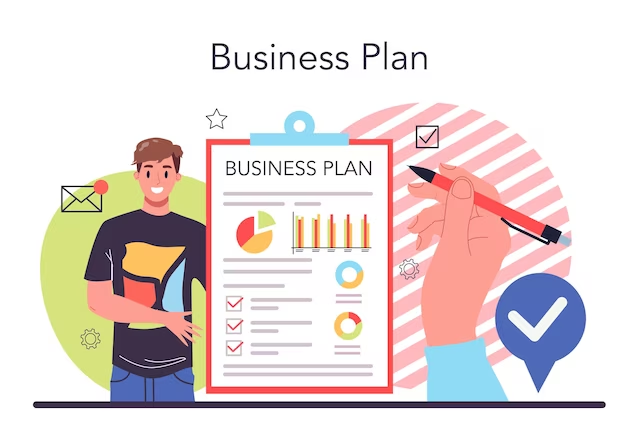Key Takeaways
- Dynamic Roadmap for Success: Explore how a business plan in 2024 is more than a static document – it’s a dynamic roadmap that adapts to technological shifts, economic changes, and evolving market trends.
- Modern Tools for Strategic Planning: Discover the essential role of modern tools and technologies in crafting an effective business plan. From AI-driven analytics to collaborative platforms, stay ahead in the planning process.
- Real-World Examples: Gain insights from industry leaders and successful startups, understand how businesses navigated challenge, and embrace strategic planning in the ever-changing business landscape of 2024.
In the fast-paced and ever-evolving landscape of the business world, the significance of a well-crafted business plan cannot be overstated.
As we step into 2024, the role of a business plan transcends its traditional purpose, becoming a dynamic roadmap that not only defines the trajectory of a company but also adapts to the fluid trends and challenges of the modern era.
In this comprehensive guide, we delve into the core elements of a business plan, exploring its redefined relevance in 2024 and offering insights into how entrepreneurs can leverage contemporary strategies to craft an effective and future-proof plan.

Understanding the Basics of a Business Plan
At its core, a business plan serves as a comprehensive document that outlines the goals, strategies, and operations of a business.
In 2024, the landscape has evolved, and so have the expectations from this foundational document.
This section will unravel the fundamental components of a business plan, shedding light on its historical evolution and emphasizing the need to align it with the dynamic nature of today’s business environment.
We’ll explore how modern business plans are not static documents but living frameworks that respond to the evolving demands of the market.
The Relevance of a Business Plan in 2024
In an era marked by technological leaps, economic uncertainties, and global challenges, the relevance of a business plan extends beyond its conventional boundaries.
This segment will dissect the impact of technological advancements on business planning, emphasizing the adaptability required to navigate the shifting economic landscape.
As businesses grapple with unprecedented challenges, we explore how a robust business plan becomes a strategic tool for resilience, helping companies anticipate and proactively address potential pitfalls.
Key Elements to Include in Your Business Plan
Crafting a business plan for 2024 requires a nuanced understanding of the essential elements that define success.
From a compelling executive summary to a detailed market analysis, this portion of the guide will dissect each component, providing actionable insights and emphasizing the importance of aligning these elements with contemporary market trends.
We’ll delve into the intricacies of financial projections, organizational structures, and risk analysis, offering a comprehensive roadmap for businesses aiming not just to survive but to thrive in the years ahead.
How to Write a Business Plan in 2024
As the business landscape undergoes rapid transformations, the process of writing a business plan demands a fresh perspective.
In this segment, we’ll explore modern tools and technologies that facilitate the planning process, emphasizing the integration of sustainability and social responsibility.
Addressing the impact of remote work and digital transformation, we provide practical tips for ensuring flexibility and adaptability in your business plan, acknowledging the importance of agility in an era defined by rapid change.
Embark on this journey with us as we demystify the intricacies of business planning in 2024, presenting not just a guide but a blueprint for success in the dynamic and challenging world of modern business.
But, before we venture further, we like to share who we are and what we do.
About AppLabx
From developing a solid marketing plan to creating compelling content, optimizing for search engines, leveraging social media, and utilizing paid advertising, AppLabx offers a comprehensive suite of digital marketing services designed to drive growth and profitability for your business.
AppLabx is well known for helping companies and startups use marketing strategies to drive web traffic to their websites and web apps.
At AppLabx, we understand that no two businesses are alike. That’s why we take a personalized approach to every project, working closely with our clients to understand their unique needs and goals, and developing customized strategies to help them achieve success.
If you need a digital consultation, then send in an inquiry here.
What is a Business Plan and How to Write It in 2024?
- Understanding the Basics of a Business Plan
- The Relevance of a Business Plan in 2024
- Key Elements to Include in Your Business Plan
- How to Write a Business Plan in 2024
1. Understanding the Basics of a Business Plan

Definition and Evolution
A business plan, in its essence, is a comprehensive document that outlines a company’s goals, strategies, and operations.
In the ever-evolving landscape of business, its role has transcended from a static blueprint to a dynamic and adaptive roadmap.
Traditionally seen as a tool for securing funding or attracting investors, a modern business plan is a living document that responds to the fluid trends and challenges of today’s market.
The Historical Shift
Historically, business plans were rigid documents crafted primarily for external stakeholders.
However, in 2024, the paradigm has shifted. With a heightened emphasis on agility and adaptability, businesses are recognizing the need for business plans to be dynamic tools that guide internal decision-making processes.
Adaptability and Continuous Improvement
In the dynamic landscape of 2024, a business plan is not a static document but a flexible framework that adapts to market shifts.
71% of the fast-growing companies have business plans.
2. The Relevance of a Business Plan in 2024

Impact of Technological Advancements
In the digital era of 2024, technology has become the cornerstone of business operations, reshaping industries and altering the competitive landscape.
Businesses that leverage technology effectively often outperform their counterparts.
A business plan in 2024 should not only acknowledge technological trends but also outline strategies to harness them for sustainable growth.
Adapting to the Changing Economic Landscape
The economic landscape is in a state of perpetual flux, influenced by global events, geopolitical factors, and market dynamics.
In 2024, businesses must navigate uncertainties such as inflation, supply chain disruptions, and geopolitical tensions.
A business plan tailored for 2024 should address macroeconomic factors, incorporating contingency plans and risk mitigation strategies to foster resilience in the face of economic challenges.
Navigating Uncertainties Through Strategic Planning
As the business environment becomes more unpredictable, strategic planning gains prominence.
Businesses must proactively identify and address potential challenges to remain agile and responsive.
For instance, during the COVID-19 pandemic, companies with robust strategic plans were better positioned to adapt.
In 2024, a business plan serves as a strategic compass, guiding businesses through uncertainties and positioning them for sustained success.
Harnessing Data for Informed Decision-Making
Data has emerged as a powerful tool for informed decision-making in contemporary business planning.
The ability to collect, analyze, and interpret data enables businesses to understand market trends, consumer behavior, and competitive landscapes.
A business plan in 2024 should integrate data analytics, leveraging tools like Google Analytics or Tableau, to inform strategic decisions and enhance operational efficiency.
Embracing Sustainability for Long-Term Success
In an era marked by heightened environmental awareness, sustainability is not just a moral imperative but a strategic necessity.
Businesses are increasingly incorporating sustainable practices into their operations.
Two-thirds (66%) are willing to pay more for sustainable products.
A business plan for 2024 should outline clear sustainability goals and strategies, not only to meet consumer expectations but also to align with global initiatives addressing climate change and social responsibility.
Reshaping Business Models Through Digital Transformation
Digital transformation is reshaping traditional business models, impacting industries across the board.
By 2026, global digital transformation spending is forecast to reach 3.4 trillion U.S.
In the context of a business plan, this implies a need to evaluate and potentially overhaul existing business models to stay competitive. Examples abound, from traditional retail adopting e-commerce strategies to manufacturing incorporating smart technologies.
A business plan must articulate how digital transformation will be embraced and woven into the fabric of the business for sustained relevance and growth.
The Role of E-commerce in Business Plans
The surge in online consumer behaviour has been accelerated by the COVID-19 pandemic and is set to continue.
According to Statista, global e-commerce sales are projected to reach about 8.1 trillion dollars by 2026.
Businesses need to recognize the pivotal role of e-commerce in their operations and incorporate strategies within their business plans to capture a share of this burgeoning market.
This might involve enhancing online platforms, optimizing user experiences, and implementing robust digital marketing strategies.
Importance of Flexibility and Agile Planning
In a rapidly changing business environment, the ability to adapt quickly is a competitive advantage.
A business plan for 2024 should reflect this need for flexibility, incorporating agile planning methodologies that allow businesses to pivot swiftly in response to market shifts, emerging trends, and unexpected challenges.
3. Key Elements to Include in Your Business Plan

Executive Summary – Crafting a Captivating Overview
- The executive summary serves as the gateway to your business plan, offering a concise yet compelling overview of your business. In 2024, with attention spans decreasing, it’s crucial to craft an executive summary that captures the essence of your business quickly.
- Example: A Tech Company’s business plan succinctly outlines its innovative product line and market positioning in a compelling executive summary, setting the stage for investor interest.

Company Description – Defining Identity and Mission
- Beyond a conventional ‘About Us’ section, the company description in 2024 is a narrative that defines your brand identity and mission. With consumers seeking purpose-driven brands, it’s essential to articulate not just what you do but why you exist.
- 73 per cent of employees who say they work at a “purpose-driven” company are engaged, compared to just 23 per cent of those who don’t.
- Example: Patagonia’s business plan intricately weaves its commitment to environmental sustainability into the company description, resonating with consumers who align with eco-friendly values.

Market Analysis – Understanding Industry and Audience
- The market analysis section demands a data-driven approach, utilizing tools like Statista or IBISWorld to glean real-time industry data. Understanding market trends and consumer behaviour is crucial for making informed decisions.
- Companies that use customer analytics extensively are more than twice as likely to generate above-average profits as those that don’t.
Organization and Management – Outlining Structure
- The organizational and management section is more than an organizational chart; it reflects your company’s culture and decision-making processes. Emphasize how the organizational structure supports your mission and fosters a positive workplace culture.
- 94% of executives and 88% of employees believe a distinct workplace culture is important to business success.
Products or Services – Detailing Uniqueness
- Clearly defining your unique selling proposition (USP) is critical in a market saturated with choices. Communicate what sets your products or services apart to capture consumer loyalty and market share.
- Sixty per cent of global consumers with Internet access prefer to buy new products from a familiar brand rather than switch to a new brand.
Marketing and Sales Strategy – Adapting to Trends
With the rise of digital marketing and e-commerce, the marketing and sales strategy section should reflect the dynamic nature of consumer behaviour. Businesses must incorporate digital strategies, such as social media marketing and influencer collaborations.
Financial Projections – Realistic Forecasting
- Accurate financial projections are vital for securing funding and sustaining operations. Leverage financial modelling tools and data analytics to create realistic forecasts that instil confidence in investors and stakeholders.
- 29 per cent of start-ups cited money and how it should be spent as a reason for failure.
Risk Analysis – Identifying and Mitigating Challenges
The risk analysis section should not only identify potential challenges but also outline robust mitigation strategies.
Proactively addressing risks is crucial for ensuring business continuity and building investor confidence.
4. How to Write a Business Plan in 2024

Utilizing Modern Tools and Technologies for Planning
- The process of writing a business plan in 2024 is significantly enhanced by the use of modern tools and technologies.
Leveraging advanced software, analytics platforms, and collaborative tools can streamline the planning process and ensure the document is not just a static blueprint but a dynamic, responsive framework. - Gen AI could enable automation of up to 70 percent of business activities, across almost all occupations, between now and 2030.
- Example: Slack, a collaboration tool, can be integrated into the business planning process, fostering real-time communication and collaboration among team members, ensuring everyone is on the same page.

Incorporating Sustainability and Social Responsibility
In an era where environmental and social responsibility are critical considerations for businesses, integrating sustainability into your business plan is essential.
Investors and consumers increasingly favour businesses that demonstrate a commitment to ethical practices and sustainable operations.
Addressing the Impact of Remote Work and Digital Transformation
The widespread adoption of remote work and digital transformation has reshaped the business landscape. In your business plan, address how your company navigates these changes.
Highlight strategies for remote collaboration, digital customer engagement, and technology adoption to stay competitive.
Tips for Ensuring Flexibility and Adaptability
Business plans in 2024 need to be agile and adaptable. Consider implementing strategies that allow for flexibility in response to market shifts, emerging trends, and unexpected challenges.
This includes scenario planning, regular plan reviews, and the incorporation of feedback loops.
Conclusion
As we conclude our exploration into the realm of business planning in 2024, it is evident that the landscape has undergone significant transformations, demanding a dynamic and adaptive approach.
The importance of a well-crafted business plan extends far beyond its traditional role, evolving into a strategic tool that navigates businesses through technological advancements, economic uncertainties, and dynamic market shifts.
Let’s recap the key takeaways from our comprehensive guide on “What is a Business Plan and How to Write It in 2024?”
Embracing Evolution: The Modern Business Plan
In the fast-paced world of 2024, a business plan is no longer a static document but a living framework that responds to the evolving demands of the market.
It serves as a dynamic roadmap, guiding internal decision-making processes and adapting to the fluid trends that define the contemporary business landscape.
From the executive summary to financial projections, each component plays a pivotal role in crafting a business plan that is not just a blueprint but a strategic compass.
Relevance in Flux: Adapting to 2024’s Challenges
The relevance of a business plan in 2024 extends beyond its traditional boundaries.
The impact of technological advancements, changing economic landscapes, and uncertainties requires businesses to proactively address challenges through strategic planning.
Key Elements for Success: Blueprinting the Future
Crafting a comprehensive business plan for 2024 involves integrating key elements that define success.
From a captivating executive summary to a detailed risk analysis, each component plays a unique role in shaping the narrative of your business.
Modern Tools and Strategies: Navigating the Contemporary Landscape
Utilizing modern tools and technologies, incorporating sustainability, addressing the impact of remote work, and ensuring flexibility are paramount in the process of writing a business plan in 2024.
Empowering Your Journey: The Call to Action
As you embark on the journey of crafting or updating your business plan in 2024, remember that it is not just a document but a strategic roadmap that guides your business toward success.
Leverage the insights shared in this guide, explore modern tools, embrace sustainability, and foster adaptability. Engage with the vibrant community of entrepreneurs, share your experiences, and continually refine your business plan as the business landscape evolves.
Unlocking Success in 2024 and Beyond
In a world characterized by change, uncertainty, and unprecedented opportunities, a well-crafted business plan is your compass, guiding you through uncharted territories.
As you navigate the future, remember that the journey is as important as the destination.
Embrace innovation, stay attuned to market dynamics, and let your business plan be a reflection of your resilience and vision. Here’s to unlocking success in 2024 and beyond – may your business plan be the catalyst for a thriving and enduring enterprise.
If you are looking for a top-class digital marketer, then book a free consultation slot here.
If you find this article useful, why not share it with your friends and business partners, and also leave a nice comment below?
We, at the AppLabx Research Team, strive to bring the latest and most meaningful data, guides, and statistics to your doorstep.
To get access to top-quality guides, click over to the AppLabx Blog.
People also ask
What is a business plan and how do you write it?
A business plan is a comprehensive document outlining a company’s goals, strategies, and operations. To write one, define your mission, analyze the market, detail your products or services, outline marketing and sales strategies, depict organizational structure, create financial projections, and address potential risks.
How do I write a business plan for the next 3 years?
To write a 3-year business plan, set clear goals, analyze market trends, outline strategies for product/service development, establish marketing and sales plans, create realistic financial projections, and incorporate flexibility for industry changes. Regularly review and adapt the plan as needed.
What is a 1-year, 3-year, or 5-year business plan?
A 1-year, 3-year, and 5-year business plan outlines short, medium, and long-term goals respectively. The 1-year plan focuses on immediate objectives, the 3-year plan on growth and stability, and the 5-year plan on achieving significant milestones and long-term sustainability.




































